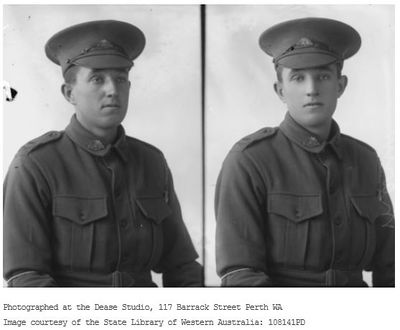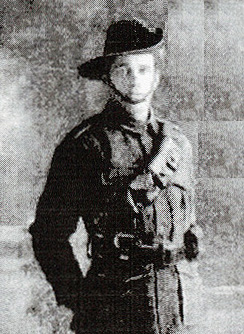William Clarence Martin DCM & Bar
From Our Contribution
 | |
 Western Mail 12 May 1916 | |
| Personal Information | |
|---|---|
| Date of Birth | 28 Dec 1890 |
| Place of Birth | Jarrahdale, Western Australia |
| Death | 29 Jan 1970, aged 79 |
| Place of Death | Floreat Park, Western Australia |
| Age at Enlistment | 24 years, 7 months |
| Description |
5' 6½" (1.69m) tall ; 156lbs 70.76 kg ; fair complexion ; grey eyes ; fair hair ; Scar over right eye. |
| Occupation | Sleeper cutter |
| Religion | Church of England |
| Address | Kelmscott, Western Australia |
| Next of Kin | Father , Mr. George Kersley Martin |
| Military Information | |
| Reg Number | 1340 |
| Date of Enlistment | 22 Jul 1915 |
| Rank | Sergeant |
| Unit/Formation | 10th Light Horse Regiment, 10th Reinforcement / 3rd Light Horse Brigade, NZ and Australian Division |
| Date of Embarkation | 13 Oct 1915 ‒ ? Nov 1915 |
| Ship Embarked On | HMAT A32 Themistocles Fremantle to Port Suez |
| Date of Return | 29 Apr 1919 ‒ 29 May 1919 |
| Ship Returned On | SS Dorset Port Said to Fremantle |
| Fate | Returned to Australia |
| Monument | Kelmscott War Memorial (North Panel) |
| Medals |
Distinguished Conduct Medal 1914-15 Star British War Medal Victory Medal |
Pre War
“William Clarence Martin (1890-1970), horseman, soldier and pastoralist, was born on 28 December 1890 at Jarrahdale, Western Australia, son of George Kersley Martin, labourer, and his wife Rose Sarah, née Markwell. He attended Kelmscott Primary School until he was 14, then went as a jackaroo to a station in the Murchison district." [1]
War Service
Martin enlisted in the Australian Imperial Force on 13 July 1915 and on October 13th he embarked on board HMAT A32 Themistocles at Fremantle with the 10th reinforcements for the 10th Light Horse Regiment. Too late for Gallipoli, they landed in Egypt in November and joined their unit the next month on its return from Gallipoli.Early in 1916 the regiment took part in the Egyptian Expeditionary Force's advance across Sinai into Palestine. Martin joined the 3rd Light Horse Brigade scouts during 1916. In April 1917 he was promoted to Lance Corporal, and after spraining his ankle in September, spent time in a rehabilitation camp at Port Said, Egypt. Soon after he was promoted Corporal, and on the day that he was confirmed in that rank, he was made a Lance Sergeant (November 1917). Promotion to Troop Sergeant occurred nine months later in July 1918, after he had distinguished himself in the first of two separate incidents providing strong leadership to the troop of scouts that he commanded.
By April 1918 the British had reached the Jordan. William's first Distinguished Conduct Medal was awarded for his efforts on 30 April 1918 in the battle known as Es Salt, an Arab village just to the west of Amman (now the capital of Jordan). Leading the advance on Es Salt through mountainous territory, William and a scout colleague encountered a standing patrol of three enemy, one of whom they killed, and the other two they captured. Soon after a larger group of fifteen enemy cavalry troopers were met by William and a now slightly larger group of four or five Australians. William immediately ordered an attack on the larger force, and they bolted for safety leaving six of their horses behind. Although his Distinguished Conduct Medal was 'awarded in the field', the citation for his award was not published until later.
After the failure to secure Es Salt the troops spent four months in the Jordan valley in oppressive heat. In September the British planned to take Damascus. On 20 Sep 1918, during the great northern cavalry drive which split apart the Turkish defence of Palestine, at a village named Kefr Adan, Sergeant Martin led his scouts into the village and encountered a large group of Turks. He and a companion rode into the village while the remaining scouts rode around the left side of the village. Martin and his colleague quickly captured some of the Turks, but when they were handed over to members of the 9th Light Horse Regiment to escort from the battlefield, they were found to number 200.
On the night of 27-28 Sep 1918, the 10th Light Horse Regiment forced the Jordan crossing above Jisr Benat Yakub in the face of heavy machine-gun and rifle fire. The group that he was travelling with encountered a mixed German and Turk force of fifty men with machine guns. At this time his troop was travelling through very difficult country in single file. After his officer was wounded in the arm, William took command and pushed on with the charge. The ground was impossible for horses, so the men dismounted. Guided by the gun flashes he led the men towards the enemy, and while the rest of 'B' Squadron surrounded the enemy, he led his group in a bayonet charge on foot. After they had killed several of the enemy and the rest of 'B' Squadron fired in their support, the remaining enemy surrendered. Twelve Germans and 40 Turks, along with a field gun and a machine gun were captured. Martin was awarded a Bar to his Distinguished Conduct Medal and confirmed in the rank of Sergeant on 6 Nov 1918.
In the opinion of his commanding officer, Martin was not only 'exceptionally brave', but possessed a 'rare intelligence and cool judgment which did not impair his brilliancy and dash'; his guide work was 'really wonderful'.
In April 1919 Martin was invalided to Western Australia with malaria and was discharged from the A.I.F. on 25 Oct 1919.[2]
Award Comment
Distinguished Conduct Medal
This non-commissioned officer was in charge of a section of the Brigade scouts acting ahead of the Brigade on its advance from JISR ED DAMIE to ES SALT on 29th April, 1918. This non-commissioned officer and one member of his section advanced to within 25 yards of an enemy observation post, unobserved, and captured two of the enemy and killed the remaining enemy. Recommended for DCM. [3]
Bar to Distinguished Conduct Medal
For gallantry and devotion to duty on the night of 27-28 September, 1918. When the Regiment forced the crossing across the river Jordan above JISH KEMAT YAKOS in the face of heavy machine gun and rifle fire, this non-commissioned officer, who was riding close to his troop officer when the later was wounded, assumed command of the troop and gallantly pushed on with the charge against the enemy's position, which resulted in the capture of fifty prisoners and two machine guns. Considering the roughness of the ground and the posi-largious (?) of the evening this non-commissioned officer's performance was a most meritorious one' [4][5]
Post War
Electoral Roll entries : 1916 - 1925 sleeper cutter at Inglehope near Holyoake; 1925 - 1968 pastoralist at Mt Padbury Station.
Following his discharge, Bill went droving in the Kimberley.
Later, using money earned from droving and his entitlement under the repatriation land settlement scheme, he bought the major share in Mount Padbury Pastoral Co. near Meekatharra. He lived there until selling out about 1969.
He had married Nellie Cooree Francisco at St Mary's Anglican Church, West Perth, on 25 January 1923. They had a son but the marriage ended in divorce.
Bill Martin was a rugged character, about 5 ft 9 ins (175 cm) tall, and a good horseman and buckjumper who loved mustering and camping out. He died of leukaemia in Sir Charles Gairdner Hospital, Perth, on 29 January 1970, leaving an estate of $72,154, and was cremated with Anglican rites.
On the basis of his appearance and performance he was chosen to represent light horsemen in a series of paintings of the A.I.F. commissioned by the Australian War Museum Committee. Two portraits by Frank Crozier are in the Australian War Memorial.”[6]